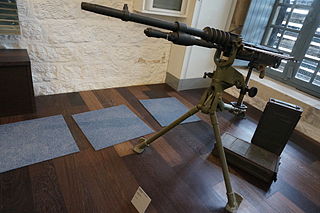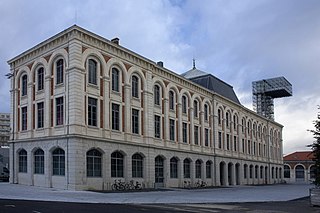The Chauchat was the standard light machine gun or "machine rifle" of the French Army during World War I (1914–18). Its official designation was "Fusil Mitrailleur Modele 1915 CSRG". Beginning in June 1916, it was placed into regular service with French infantry, where the troops called it the FM Chauchat, after Colonel Louis Chauchat, the main contributor to its design. The Chauchat in 8mm Lebel was also extensively used in 1917–18 by the American Expeditionary Forces (A.E.F.), where it was officially designated as the "Automatic Rifle, Model 1915 (Chauchat)". A total of 262,000 Chauchats were manufactured between December 1915 and November 1918, including 244,000 chambered for the 8mm Lebel service cartridge, making it the most widely manufactured automatic weapon of World War I. The armies of eight other nations—Belgium, Finland, Greece, Italy, Poland, Romania, Russia, and Serbia—also used the Chauchat machine rifle in fairly large numbers during and after World War I.

The Browning Automatic Rifle (BAR) is a family of American automatic rifles and machine guns used by the United States and numerous other countries during the 20th century. The primary variant of the BAR series was the M1918, chambered for the .30-06 Springfield rifle cartridge and designed by John Browning in 1917 for the American Expeditionary Forces in Europe as a replacement for the French-made Chauchat and M1909 Benét–Mercié machine guns that US forces had previously been issued.

The Lebel Model 1886 rifle also known as the "Fusil Mle 1886 M93", after a bolt modification was added in 1893, is an 8 mm bolt-action infantry rifle that entered service in the French Army in 1887. It is a repeating rifle that can hold eight rounds in its fore-stock tube magazine, one round in the elevator plus one round in the chamber; equaling a total of ten rounds held. The Lebel rifle has the distinction of being the first military firearm to use smokeless powder ammunition. The new propellant powder, "Poudre B," was nitrocellulose-based and had been invented in 1884 by French chemist Paul Vieille. Lieutenant Colonel Nicolas Lebel contributed a flat nosed 8 mm full metal jacket bullet. Twelve years later, in 1898, a solid brass pointed (spitzer) and boat-tail bullet called "Balle D" was retained for all 8mm Lebel ammunition. Each case was protected against accidental percussion inside the tube magazine by a primer cover and by a circular groove around the primer cup which caught the tip of the following pointed bullet. Featuring an oversized bolt with front locking lugs and a massive receiver, the Lebel rifle was a durable design capable of long range performance. In spite of early obsolete features, such as its tube magazine and the shape of 8mm Lebel rimmed ammunition, the Lebel rifle remained the basic weapon of French infantry during World War I (1914–1918). Altogether, 3.45 million Lebel rifles were produced by the three French state factories between 1887 and 1916.

Personal defense weapons (PDWs) are a class of compact, magazine-fed, submachine gun-like automatic firearms designed to fire rifle-like cartridges. Most PDWs fire a small-caliber, high-velocity centerfire bottleneck cartridge resembling a scaled-down intermediate cartridge, essentially making them an "in-between" hybrid between a submachine gun and a carbine.

The Mle 1914 Hotchkiss machine gun chambered for the 8mm Lebel cartridge became the standard machine gun of the French Army during the latter half of World War I. It was manufactured by the French arms company Hotchkiss et Cie, which had been established in the 1860s by American industrialist Benjamin B. Hotchkiss. The gas-actuated Hotchkiss system was first formulated in 1893 by Odkolek von Ujezda and improved into its final form by Hotchkiss armament engineers, American Laurence Benét and his French assistant Henri Mercié.

The Fusil-mitrailleur Modèle 1924 M29, designed in 1924 by the Manufacture d'armes de Châtellerault, is a 7.5×54mm French light machine gun, which was the standard issue machine gun of the French Army from 1925 until the 1960s and was in use until 2000-2006 with the National Gendarmerie.

The 8×50mmR Lebel rifle cartridge was the first smokeless powder cartridge to be made and adopted by any country. It was introduced by France in 1886. Formed by necking down the 11×59mmR Gras black powder cartridge, the smokeless 8mm Lebel cartridge started a revolution in military rifle ammunition. Standard 8mm Lebel military ammunition was also the first rifle ammunition to feature a spitzer boat tail bullet, which was adopted in 1898. The long-range ballistic performance of the 8mm Lebel bullet itself was exceptional for its time. For use in the magazine tube-fed early Lebel rifle, the 8 mm case was designed to protect against accidental percussion inside the tube magazine by a circular groove around the primer cup which caught the tip of the following pointed bullet. However, the shape of its rimmed bottle-necked case, having been designed for the Lebel rifle's tube magazine, also precluded truly efficient vertical stacking inside a vertical magazine. The bolt thrust of the 8mm Lebel is relatively high compared to many other service rounds used in the early 20th century. Although it was once revolutionary, the 8mm Lebel was declared obsolete after World War I and was soon after replaced with the 7.5×54mm French round.
The Meunier rifle, known as the "Meunier A6" or "STA No. 8", evolved as a part of the program initiated in 1890 by the French military to develop a semi-automatic infantry rifle that would eventually replace the Mle 1886–93 Lebel rifle. Four government research establishments proposed over 20 prototypes. About half of them were based on recoil and the others were gas operated. This secret program was placed under the direction of General Naquet-Laroque who headed the Puteaux (APX) government arsenal.

The Manufacture d'Armes de Châtellerault, often abbreviated to MAC, was a French state-owned weapons manufacturer in the town of Châtellerault, Vienne. It was created by a royal decree of 14 July 1819 to manufacture swords, then firearms and cannons. Antoine Treuille de Beaulieu in 1840 began to develop the concept of rifled artillery at Châtellerault for the French Army. The Lebel Model 1886 rifle, the first military firearm to use smokeless powder ammunition and the primary French infantry weapon during World War I, was developed and produced here.

The Manufacture d'Armes de Saint-Étienne, often abbreviated to MAS was a French state-owned weapons manufacturer in the town of Saint-Étienne, Loire. Founded in 1764, it was merged into the French state-owned defense conglomerate GIAT Industries in 2001.
Atelier Mécanique de Mulhouse (AME), formerly known as Centre d'Études et d'Armement de Mulhouse (CEAM), was a French small arms manufacturer which operated from 1946 to 1967.

The French St. Étienne Mle 1907 was a controversial gas operated air-cooled machine gun in 8mm Lebel which was widely used only in the early years of the First World War. For “political reasons”, the "St.Etienne Mle 1907" was developed not to derive from the patented Hotchkiss machine gun. Instead, to avoid patent infringement and royalties, it borrowed its gas operated, blow-forward design from the semi-automatic Bang rifle of 1903. The Bang system, first transposed by 1905 to the French Puteaux APX Machine Gun, had proved unsatisfactory enough to inspire its redesign by 1907 as the "St-Étienne" machine gun. However the Mle 1907 "St-Étienne" was only a partial redesign: the original blow-forward gas piston, rack-and-pinion system, and bolt mechanism of the Mle 1905 "Puteaux" machine gun had all been kept only slightly modified inside the newer weapon. Eventually a total of over 39,700 "St-Étienne" Mle 1907 machine guns were manufactured between 1908 and late 1917. They were widely used by French infantry only during the early part of World War I until their replacement by the more reliable Hotchkiss M1914 machine gun.
The Ribeyrolles 1918 was an attempt to manufacture an automatic rifle for the French forces. It was chambered in the experimental 8×35mm round, used straight blowback, was fed from a 25-round detachable magazine and had an effective range of 400 meters. The cartridge, which some argue was the first purpose-built intermediate cartridge, was obtained by necking down the .351 Winchester Self-Loading. Another source indicates that it was chambered in a cartridge designated 8×32mmSR.
The Fusil Automatique Modèle 1917, also called the RSC M1917, was a gas-operated, semi-automatic rifle placed into service by the French Army during the latter part of World War I. It was chambered in 8mm Lebel, the rimmed cartridge used in other French Army infantry weapons of the time. In total, the French national armories, primarily Manufacture d'armes de Saint-Étienne (MAS) and Manufacture Nationale d'Armes de Tulle (MAT), manufactured 86,000 RSC M1917 rifles until production ended in late November 1918. However, very few examples have survived in fully-functional, semi-automatic condition and those have become highly sought-after collectibles.

French nails were locally fabricated and converted bayonets, knives and stabbing weapons for use in the First World War. These were crude stabbing spikes made by adding a point to a steel stake which had its rearmost section heated and bent into a crude handle.
The Atelier de Construction de Puteaux (APX) was a state arsenal belonging to the French Army. It was located at 8, quai national in Puteaux.









